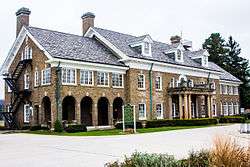Dorr E. Felt Mansion
|
Dorr E. Felt Mansion | |
 | |
  | |
| Location | 66th St. and 128th Ave., Laketown Township, Michigan |
|---|---|
| Coordinates | 42°41′49″N 86°11′37″W / 42.69694°N 86.19361°WCoordinates: 42°41′49″N 86°11′37″W / 42.69694°N 86.19361°W |
| Area | 3 acres (1.2 ha) |
| Built | 1927 |
| Architect | Frank P. Allen & Son |
| Architectural style | Classical Revival |
| NRHP Reference # | 96001418[1] |
| Added to NRHP | December 12, 1996 |
The Felt Mansion is a house located at 66th Street and 128th Avenue, in Laketown Township, Michigan near Saugatuck, Michigan. It was listed on the National Register of Historic Places in 1996.[1]
History
Dorr Felt was born in 1862 near Beloit, Wisconsin. At eighteen, he moved to Chicago, becoming a foreman at a rolling mill. In 1885, he hit upon the idea of constructing a calculating machine to aid the shop's accountants. He eventually developed and patented his machine, and in 1889 opened a factory. His company was successful, and Felt also served in a number of prominent positions in government and business groups. Felt married Agnes McNulty in 1891 and the couple had four daughters. The Felts first visited the Saugatuck area in the early 1900s as a tourist, and fell in love with the area. Starting in 1919, they began acquiring land in the area, and in 1926 purchased the lots where this house now stands. At the time, the Felts lived in a modest farmhouse on the site, which has since been demolished.[2]
In 1927, the Felts hired the Grand Rapids architectural firm of Frank P. Allen & Son to design this summer house.[2] Construction began in July 1927, and was completed in 1928.[3] In August 1928, Agnes Felt suddenly died at the estate. Dorr Felt remarried the next year, but his new wife preferred living in Chicago to the summer estate. Dorr Felt died in August 1930. The mansion was left to his children, who kept it until 1949, when it was sold to the Chicago Province of the Augustinian Order of the Catholic Church.[2]
The Felt Mansion became the St. Augustine Catholic Seminary preparatory school in 1949. The Mansion served as a chapel and housed priests and students. In 1962 the Augustinians leased the Mansion to Dominican cloistered nuns. In 1963 the Order of Saint Augustine constructed a Seminary on the Felt Estate. This preparatory school contained a chapel and housing for priests as well as students in grades 9-12.[3]
In 1977 the Felt Estate was purchased by the State of Michigan. The State of Michigan used the Felt Mansion as a state police post and converted the school building into the Saugatuck Dunes Correctional Facility.[3]
The prison was closed in 1991.[2] In 1995 the state sold 44 acres of the Estate, including the Mansion and prison building, to Laketown Township for $1, stipulating that the mansion be preserved and that it be owned and operated by the public. The Friends of the Felt Estate formed in 2002 and began restoration of the house and grounds. The property is listed in the National Register of Historic Places.[3]
Description
The Felt Mansion is a three-story, gable-roof, rectangular plan brick mansion. It is constructed of steel beams with a concrete and wire mesh lath, and sits on a concrete foundation. The roof is made of concrete slabs supported by steel trusses, and is covered with slate tiles. The main body of the house is six bays wide, flanked by slightly recessed four-bay wide wings. Exterior walls are clad in yellow brick, with prominent decorative limestone window sills, keystones, and panels between the first-floor and second-floor windows. The front entry is covered with a limestone portico. A variety of windows are used through the house, with one-over-one, double-hung windows on the main body, round-arch windows on the first floor of the wings, and three-part wooden casement windows on the second story. [2]
The interior has a central hall with rooms symmetrically arranged around it. The northern portion of the house contained the dining room with a kitchen and pantry, a small library, and a sun porch. The south portion had a large solarium in the front of the house and a living room in the rear. A central staircase leads to the second floor, the south side held family rooms, including a master suite with a bedroom, an anteroom with a walk-in cedar closet, a sun porch, and a tiled bathroom. Additional bedrooms for children and guests take up most of the remaining space, and the north side had sleeping quarters for servants. The third floor contained a ballroom.[2]
Legend
According to legend, the mansion is a place where melon heads lived.[4]
References
- 1 2 National Park Service (2010-07-09). "National Register Information System". National Register of Historic Places. National Park Service.
- 1 2 3 4 5 6 Amy L. Arnold (October 1996), NATIONAL REGISTER OF HISTORIC PLACES REGISTRATION FORM: Felt, Dorr E., Mansion (note: large pdf file)
- 1 2 3 4 "A Colorfully Woven History". FeltMansion.org. Retrieved September 29, 2013.
- ↑ "The origin of the Melon Heads". Grand Haven Tribune. Retrieved September 29, 2013.